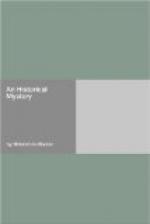Madame Michu looked appealingly to heaven. A beautiful fair woman with blue eyes, composed and thoughtful in expression and made like an antique statue, she seemed to be a prey to some dark and bitter grief. The husband’s appearance may explain to a certain extent the evident fear of the two women. The laws of physiognomy are precise, not only in their application to character, but also in relation to the destinies of life. There is such a thing as prophetic physiognomy. If it were possible (and such a vital statistic would be of value to society) to obtain exact likenesses of those who perish on the scaffold, the science of Lavatar and also that of Gall would prove unmistakably that the heads of all such persons, even those who are innocent, show prophetic signs. Yes, fate sets its mark on the faces of those who are doomed to die a violent death of any kind. Now, this sign, this seal, visible to the eye of an observer, was imprinted on the expressive face of the man with the rifled carbine. Short and stout, abrupt and active in his motions as a monkey, though calm in temperament, Michu had a white face injected with blood, and features set close together like those of a Tartar,—a likeness to which his crinkled red hair conveyed a sinister expression. His eyes, clear and yellow as those of a tiger, showed depths behind them in which the glance of whoever examined the man might lose itself and never find either warmth or motion. Fixed, luminous, and rigid, those eyes terrified whoever gazed into them. The singular contrast between the immobility of the eyes and the activity of the body increased the chilling impression conveyed by a first sight of Michu. Action, always prompt in this man, was the outcome of a single thought; just as the life of animals is, without reflection, the outcome of instinct. Since 1793 he had trimmed his red beard to the shape of a fan. Even if he had not been (as he was during the Terror) president of a club of Jacobins, this peculiarity of his head would in itself have made him terrible to behold. His Socratic face with its blunt nose was surmounted by a fine forehead, so projecting, however, that it overhung the rest of the features. The ears, well detached from the head, had the sort of mobility which we find in those of wild animals, which are ever on the qui-vive. The mouth, half-open, as the custom usually is among country-people, showed teeth that were strong and white as almonds, but irregular. Gleaming red whiskers framed this face, which was white and yet mottled in spots. The hair, cropped close in front and allowed to grow long at the sides and on the back of the head, brought into relief, by its savage redness, all the strange and fateful peculiarities of this singular face. The neck which was short and thick, seemed to tempt the axe.




